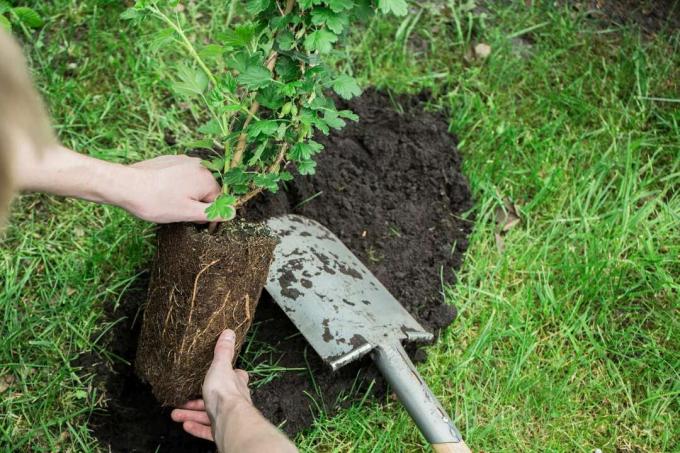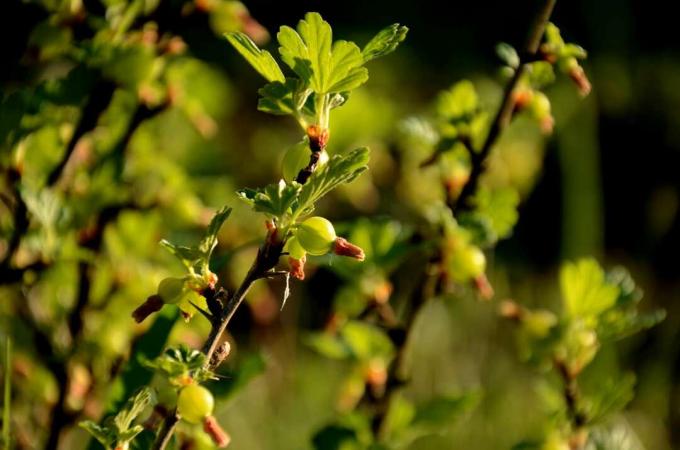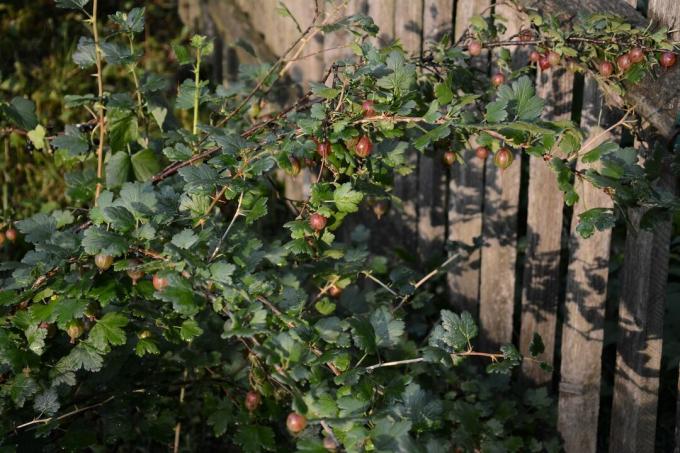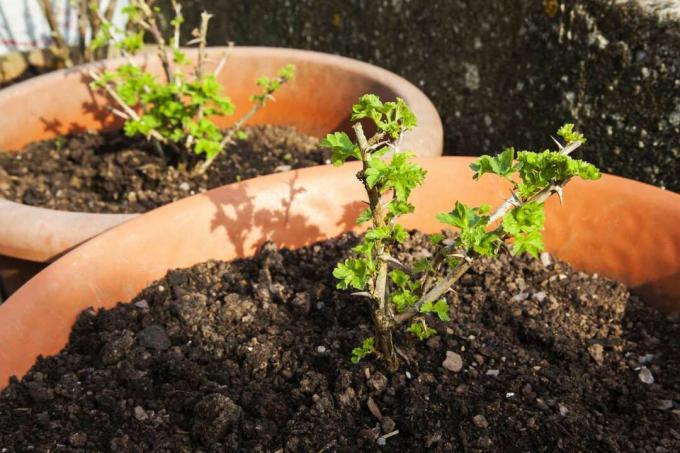Gooseberries taste very good and should therefore not be missing in any garden. The best way to go about planting the gooseberry can be found here.

the Gooseberry (Ribes uva-crispa) belongs to the genus of currants (Ribes), just like their close relatives, the red and white currants (Ribes rubrum) and the black currants (Ribes nigrum). The color and taste of the gooseberry fruits are very different from variety to variety. In contrast to Strawberries (Fragaria x ananassa), Raspberries (Rubus idaeus) and blueberries (Vaccinium corymbosum) they are often only offered for a short time in supermarkets. Since gooseberries are never harvested fully ripe for the retail trade because they would otherwise be too soft for transport, the taste is often lacking in aroma and sweetness. Gooseberries thrive wonderfully in our home gardens and can bring very large yields on the bush. We give tips on planting gooseberries, the ideal time and the procedure for planting in pots and beds.
contents
-
Planting gooseberries: requirements
- When to plant gooseberries
- The ideal location for gooseberries
- The right soil for gooseberries
- Planting gooseberries: instructions
- Plant gooseberries in the tub
Planting gooseberries: requirements
Before planting, you should first deal with the choice of variety. So there is a great variety of Gooseberry varieties in red, green and yellow colors. They differ mainly in the taste of the fruit, in the form of the reinforcement with spikes and the resistance to diseases. Cultivated forms with fewer spines make harvesting easier. Due to the high susceptibility of gooseberries to powdery mildew, you should also use varieties that are as resistant as possible. The timing of planting and the right location also play a crucial role in growing gooseberries to be successful.
When to plant gooseberries
Hobby gardeners often ask when to plant gooseberries, in autumn or in spring? The best time to plant gooseberries is in late autumn from October to November. By then the plants have already shed some leaves and are going into hibernation. Now you can also use the winter moisture of the soil for growth and the soil can settle well until spring. The shrub does not produce fresh leaves until next spring, but the gooseberry plant has enough time to form new roots and anchor itself in the ground. Some of the freshly planted gooseberries bear fruit for the first time in the following year. If you missed planting in autumn, you can still plant gooseberries in early spring before the plants start sprouting in April.

Tip: When planting in spring you should ensure a good water supply, as heat and drought can affect the barely rooted plants.
The ideal location for gooseberries
Gooseberries prefer bright, sunny locations on nutrient-rich, humus-rich and loose soils that can store moisture well. If there is limited space in the garden, they can be planted between fruit trees or as a border hedge, because gooseberries also thrive sufficiently well in partial shade. The gooseberry is native to us and completely hardy as a plant. The flowers, which appear as early as April to May, are, however, sensitive to frost. For this reason, locations protected from wind and cold are preferable for a rich harvest. If you do not want to take any risks in suboptimal locations, you should alternatively resort to late-blooming varieties. Dry southern locations, which often only heat up temporarily in spring, are less suitable for gooseberries than eastern or northern slopes.

Tip: Humid locations, especially those with shade and dew formation in the morning, encourage powdery mildew and should be avoided.
The right soil for gooseberries
The optimal soil for gooseberries is neither too light nor too heavy, nutrient-rich and well-drained. The pH should be in the slightly acidic range between 6 and 7. These conditions are given on dark, humus garden soils that are supplied with compost or other organic fertilizers. The gooseberry root system is sensitive to both waterlogging and drought. Very heavy soils can therefore be improved up to a third each with sand and compost or ready-mixed potting soil. On the other hand, very sandy soils also benefit from Soil improvements. For example, water-storing clay minerals such as bentonite, which is worked into the soil at 1-4 kg per m², can be added.
In sandy soils, there is often a lack of humus, so either compost should be added to 2-3 liters per m², or potting soil with a high content of organic matter, like ours Plantura organic universal soil. Always work in the soil-improving materials extensively and deeply and not just in the planting hole, so that your soil improves in the long term.
Soils that are already sufficiently good can be improved with a gift of high-quality potting soil and thus facilitate the growth of the gooseberries. Our Plantura organic universal soil is of course also suitable for growing gooseberries in pots and pots.
Planting gooseberries: instructions
In autumn, tree nurseries offer their gooseberries either as container or root goods. The former sit in their own pot of soil, the latter in a field. The root material is dug up and sold completely without soil or pot, this is also called "bare-rooted". Both forms are equally suitable for transplanting in your own garden. Two to three year old gooseberry plants with strong roots can already bear the first fruits in the following year.
Tip: Gooseberry stems have to be tied permanently with a wooden stake because they cannot bear the weight of their crown and fruits themselves. The wooden stake is hammered into the ground for a third of its length and the gooseberry is well attached to three points: the stem, the refinement point and the leading shoot of the crown.

Instructions - this is how to go about planting gooseberries:
- Before planting, you should loosen the soil deeply and extensively with a digging fork or spade and then improve the soil with the above measures if necessary.
- Now dig a sufficiently large planting hole for the berry plant. The planting distance for gooseberries is around 80 to 150 cm, depending on the variety and habit. Broad-growing bushes and tall trunks require a little more space than closely set hedge plants.
- Potting soil, the excavated soil and some mainly organic slow release fertilizer are mixed. Applying a slow release fertilizer like ours Plantura organic universal fertilizer or from compost ensures an optimal supply of nutrients during the growth phase in spring.
- In the case of bare-root plants, cut back all the roots by a few centimeters with a pair of secateurs. This stimulates the formation of the roots and the gooseberry quickly anchors itself in its new location. In the case of container goods, the roots of the pot ball should also be slit several times with a pair of secateurs or a knife to stimulate branching.
- In order to obtain a high-yielding and well-built gooseberry bush, the shoots must also be pruned. To do this, shorten the existing shoots by about a third, just above an outward-facing bud.
- The plant is then placed in the hole, but it should not sit so deep that the transition from the root to the shoot is buried under the ground. Now fill the planting hole with soil and step on the surface. Do not forget to ensure that the new plant is adequately watered. In the case of small stems, the support post is driven in directly next to the root ball before filling.
- A raised watering rim formed from earth around the freshly planted gooseberry bush makes regular watering much easier.
tip: A mulch layer made of lawn clippings, leaves or coarse compost avoids competition from weeds and keeps the moisture in the soil.
Plant gooseberries in the tub
The tasty berries also thrive in large planters. Here too, planting is best done in autumn. The pot or bucket should initially have a volume of at least 50 liters and have good water drainage in order to effectively avoid waterlogging in the pot. Now fill your planter with nutrient-rich soil and place the gooseberry in it. Here, too, make sure that the plant does not sit deeper than it was in the pot. Only the roots, but not the branches or the trunk, should be covered with soil. The incorporation of mainly organic slow-release fertilizer or ripe compost is in the pot for A good supply of nutrients is particularly important, as the supply is limited by the smaller volume of soil is. Press the soil well around the roots and then water extensively.

tip: Gooseberries planted in pots are much more sensitive to frost. The soil and the roots can freeze through and cause the plant to die off. Therefore, overwinter gooseberries in the tub at best frost-free, bright and cool in the garden shed, shed or greenhouse. Alternatively, you can wrap your pot with an insulating layer of fleece or something similar to protect it from frost.
Berry bushes often delight us with their delicious fruits for many years and decades. The supply of nutrients is an important issue for a good yield and long-lasting, healthy plants. Everything for Fertilizing gooseberries You can therefore find out in our special article.

